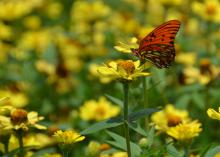Information Possibly Outdated
The information presented on this page was originally released on June 15, 2018. It may not be outdated, but please search our site for more current information. If you plan to quote or reference this information in a publication, please check with the Extension specialist or author before proceeding.
Help pollinators with a few simple steps
PICAYUNE, Miss. -- Pollinators are important to flowering plants and the food supply, but dwindling numbers of some of these creatures, including monarch butterflies and bees, have captured the public’s attention.
Many people want to help. But what can homeowners do to support these important pollinators?
Jennifer Buchanan, senior curator at the Mississippi State University Crosby Arboretum in Picayune, shared her top three tips for creating a pollinator-friendly garden.
First, include plants for all life stages. Gardens and landscapes should have host plants suitable for insects to lay eggs, nectar plants for adults to feed on and other plants to provide shelter. Only a few host plants are compatible with some species, such as butterflies and moths, so make sure to choose ones that support the target pollinator.
Second, avoid using pesticides whenever possible. Instead, use natural methods, such as hand picking, to control harmful insects. If pesticides cannot be avoided, apply them carefully and do not let them drift into areas where target pollinators visit or live.
Third, choose a safe area to install pollinator plants and gardens. Plant as far away from the road as possible to help pollinators avoid collisions with vehicles.
Insects are not the world’s only pollinators. Birds and small mammals, such as mice and bats, also transfer pollen from plant to plant.
“There are lots of categories of pollinators that go beyond just insects,” said Buchanan. “Hummingbirds don’t need host plants, but they do need a safe place to raise their young and a source of food. Be mindful of which species you want to attract, and choose a variety of plants based on their needs.”
Water is a must for all wildlife. Birds love bird baths, but butterflies prefer very shallow water. Fill a saucer with pebbles, and add water. Butterflies also need minerals, which can be added to this water.
“You can dissolve a product called Instant Ocean or kitchen salt into the water before pouring into the saucer,” Buchanan said. “If you use kitchen salt, make sure it is pure and that there isn’t any iodine or other additive in it.”
Support for pollinators can be done in lots of forms, from entire landscapes to a few plants on the patio, Buchanan said.
“A trend in some areas of the country is to turn the yard into a prairie instead of having a landscaped yard,” Buchanan said. “But even if you live in an apartment, you can plant a few containers that will attract birds, bees and butterflies. It can be that simple.”
For those who want to help bolster bee numbers, planting a diverse array of high-quality nectar plants will do the trick, said Audrey Sheridan, an Extension and research associate.
Gardeners should pay attention to flower color and shape. Honeybees cannot see red flowers very well, but they can see a wide range of colors, Sheridan said.
“Honeybees are most attracted to white, blue and violet flowers,” she said. “You can group these together without disturbing honeybees’ habit of visiting similar looking flowers, which is called flower constancy and helps bees maximize their foraging efforts. Bumblebees also do this but not as much. Solitary bees don’t exhibit this behavior and tend to feed on a narrower variety of plant species.”
Bees also choose plants by flower shape because of the length of their tongues. Cellophane and yellow-faced bees have short tongues -- less than 3 mm. Honeybees have medium-length tongues -- up to 8 mm -- and can gather nectar from variously shaped blooms. Bees with long tongues, such as bumblebees and carpenter bees, can reach into long, tubular blooms, Sheridan said.
“Because of the flower constancy behavior exhibited by honeybees and other social bees, it is best to plant individual species in large groups or drifts,” Sheridan said. “If gardeners don’t have the space for this, or if they don’t want that particular look, they can plant small groups of the same species throughout the flower bed. That pattern makes it easy for these bees to hop from one group to the next.”
Honeybees love herbs, such as basil, oregano, thyme, rosemary and sage. Regional native plants will help the native solitary bees that are adapted to these plants. Some good choices include coneflower, coreopsis, goldenrod, yarrow and American holly.
For more information about creating suitable habitat for pollinators along with a list of suggested plants for hummingbirds and butterflies, consult Extension Publication 2402, “Establishing a Backyard Wildlife Habitat.” For more information about supporting bees, consult Extension Publication 2976, “Gardening for Beneficial Bees.”
Pollinators will be featured during the June 25 session of the Mississippi State Trial Gardens storytelling series, The Story of Plants and People. Speaker Harvey Cotton will present The Story of the Birds and Bees: Protecting Pollinator Health from 6 to 8 p.m. at the Bost Conference Center on the MSU campus.







